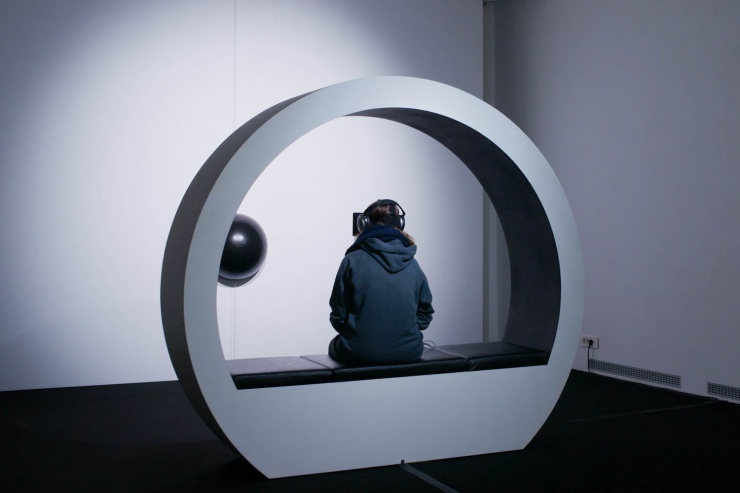Saša Spačal and Matic Potočnik: Liminoid
Augmented and virtual experience of disintegrating subjectivity | new media installation
ANNOUNCING: December 5 – 8 2018 @ osmo/za, Ljubljana
SCHEDULE: The installation can be experienced individually, possible time slots are available here. For reservations please write to delavnica@ljudmila.org.
Past events
- Festival IZIS #7, Monfort | July 5th - August 3rd, 2019 | Portorož
- May 13th - 16th 2019 |Queens Festival, Aalborg University | Copenhagen, Denmark
- December 5th – 8th 2018 | osmo/za | Ljubljana, Slovenia
- September 23rd – October 4th 2015 | _Device_art 5.015, Zagreb, Croatia
- 12th – 28th of November 2014 | Solo exhibition at Aksioma Project Space, Resljeva 7, Ljubljana | Exhibition opening on NOV 12 at 8pm
- December 17th 2013 | Presentation and artist talk at Kunstuniversität Linz, department of Interface Cultures, Linz, Austria
- December 17th 2013 | Opening at Werkstatt am Hauptplatz, Linz, Austria
Concept
Liminoid is a portal which triggers a transition between virtual and augmented realities, thus leading to the experience of disintegrating subjectivity. In the context of anthropology, the term liminoid state describes the experience of the liminal stage of a transient selfhood that occurs during rites of passage. Much like liminality in tribal cultures, the liminoid experience, which signifies contemporary society, is achieved through a three-phase passage of separation from the old self, a transitional phase that is characterized by ambiguity and disorientation, and finally a phase of incorporation and the formation of new perspectives. This three-fold experience in Liminoid is reflected in the dramaturgy of the visual experience in the virtual / augmented reality headset, although the artists do not simply translate mental processes by visual means. Liminoid is thus not merely a simulation of the liminoid stage, but instead offers a number of augmented and virtual twists on it, thus making possible the realization of post-structural concepts such as the disintegration of subjectivity, the becoming, the virtual, the immersion and identification. The experience offers an intense and even rather unpleasant sensation of uncertainty, anxiety and existential fear. Liminoid thus represents potentiality, and the participant is in for a surprise.
The system is based on virtual reality headset primarily designed for immersive gaming. The artists have modified this technology by adding a webcam to ensure a hybrid experience of virtual and augmented vision. Liminoid as a place of transition, a threshold that is also equipped with panoptical cameras overseeing the installation space, and incorporated in the dramaturgy of the visual experience. The participant is seated in a comfortable chair, in order to prevent any adverse physical reactions to the immersive experience, which might result in disorientation, dizziness or even nausea.
The device enables the viewer’s perceptual field to expand in an experience of dispersion, which then collapses at the point of emergence and ultimately appears as a fundamental boundary as circle of stones, which bears witness to the physical reality of mental and virtual experience. The movement and interaction of matter, which is as much physical as it is virtual, forms an emergent vortex. The network originates from the spiral - an all-encompassing network where all of the possible realities reside.
In the context of anthropology, the term liminoid describes the experience of the liminal stage of transience that occurs to the self during rites of passage.
A liminoid experience thus defines an undetermined set of rules that triggers a transformation in the sense of self. The three-fold experiences is reflected in the dramaturgy of the visual experience in the virtual and augmented reality headset, although the artists do not simply translate mental processes by visual means. By engaging the participant in this mental process, the artists have given the term an extended meaning. The liminoid in their installation is in fact the participant, who becomes a liminal android, an elusive organism that becomes pure form for the transition from one identity to the other. The virtual space offers an endless multitude of forms and folds, it appears both everywhere and nowhere at the same time, and thus this space is inherently liminoid. The "pure becoming without being" (Slavoj Žižek, Organs Without Bodies: On Deleuze and Consequences, Routledge, 2004, p. 8.) in the virtual space is the ideal place to experience the modes of appearance and disappearance of the idea of the self.
Liminoid poses a question of with regard to consciousness, the self and transformation. In recent years, the legitimacy of the concept of the self has been questioned both by neuroscientists and philosophers. Therefore, the first-person perspective must be taken very seriously, abandoning also the need for an egological perspective, within which an ego would work as an agent of the experience. The installation addresses the "pre-reflective self-awareness, that is not something we initiate or control; it is something that precedes all performances and should, consequently, not be attributed to an ego, but rather be understood as an egoless occurrence" (Dan Zahavi: Subjectivity and Selfhood. Investigating the First-Person Perspective, MIT Press, 2005, p. 99).
To further this notion, the basic bodily functions become the generators of the shapes seen in the installation. The pulse sensor transmits visual projections of human heartbeats that may be used to induce an "out-of-body experience," according to the Swiss Federal Institute of Technology in Lausanne. Their research has proven a correlation between the virtual representation of the heartbeat via an avatar and the formation of empathy that promotes the treatment of self-perception disorders. The rhythm of one’s heart visualized in an immersive environment induces a sense of identification and connects the viewer with themself. This forms a holistic approach that views the sense of self as a cocktail of social, environmental, sensory and hormonal factors. In contrast to what occurs within everyday experience, there is no fixed position for the sense of self. It is thus in constant becoming, conditioned by the entirety of the human experience, both physical and mental.
In the dramaturgy of the generative video experience, the folding and unfolding of subjectivity is represented by a concentric shapes. The constant fluid folding, unfolding, and dispersion of the geometrical shapes is an aesthetic representation of our temporal and spatial configurations, which produce new modes of subjectivity. The point of (dis)orientation becomes a deep, dark dimension that allows us to lose and recuperate ourselves. Liminoid as an interface for human liminoid experience is a product of computer generated synthetic images and sound, but at the end of the day the effects depend on our personal notions of timespace.
Text: Ida Hiršenfelder
Follow the project on the blog.
About artists
Saša Spačal is an intermedia artist and a graphic designer with background in humanities, who has expanded her knowledge of computer graphics, web and video production at various workshops. She is currently working in the fields of graphic design, real-time interactive visualization and intermedia art, trying to connect various technological and biological organisms. She has taken part in exhibitions and projects in Moderna galerija, Galerija Škuc and Galerija Alkatraz. As a member of Temp group she had participated in public interventions and installations, in the development of strategies for alternative use of abandoned spaces, and in exhibitions Odprti Rog, Pogovarjanja/Conversations/Conversas, Mapiranje/arhiviranje/analiziranje izginulih prostorov umetnosti. As a researcher, she had taken part in the international research project Performing the City. Art Actionism in Public Space in 1960s/1970s that had made its rounds in Munich, Naples, Sao Paulo, and Paris. Her interactive installations were presented at various international exhibitions and festivals such as Haip festival – Ljubljana, Enter 5: Datapolis – Prague, AmberFest’11: Next Ecology – Istanbul, De:sonanz 2012 – Skopje, Device_art 4.012. – Zagreb, Device_art 4.013 – Prague and Enter 6: Biopolis – Prague. Currently she is developing several new projects that focus on interfaces between living and technological organisms in collaboration with Kapelica Gallery, Multimedia Center Kibla and Ljudmila – Ljubljana digital media lab. In the field of interactive visualization and sound design she is developing strategies for usage of physical interfaces for generating sound and visuals as a member of Theremidi Orchestra. Together with Ida Hiršenfelder she is developing ČIPke platform, an initiative for researching the conditions of women who are active in the context of science, technology and media art. ČIPKe platform will open a space for conversation about women working in these fields and try to form a women friendly hackerspace with practical educational programs.
Matic Potočnik is a programmer with an interest in new media art, especially mixed reality and game development. Currently he’s finishing a masters-equivalent degree in computer science at the Faculty of Computer and Information Science, University in Ljubljana. He keeps busy with developing and analyzing software, watching science fiction movies, and with excessive use of internets. He has worked alongside Dominik Mahnič on project Lumen – Drawing in Augmented Reality, which was presented at Kiblix 2011, Alkatraz gallery, Škuc gallery, and at Device_art 4.012 in Zagreb. He has also collaborated with Dan Adlešič and Tilen Sepič on Form From Form, a mixed reality project, which was set up in Galerija Vžigalica for the festival Svetlobna Gverila (Lighting Guerrilla).
Credits
Authors: Saša Spačal and Matic Potočnik
Text: Ida Hiršenfelder and Saša Spačal
Construction and technical support: Anil Podgornik, Mirjan Švagelj and Valter Udovičić
Special credits: Anil Podgornik, Mirjan Švagelj, Tomaž Kučer (MSUM), Tina Dolinšek, Igor Križanovskij, Ida Hiršenfelder, Aileen Derieg and Uroš Veber.
Production: Ljudmila – Art and Science Laboratory (Tina Dolinšek).
Project production (2014) and upgrade (2018) was supported by Ljubljana City Municipality (MOL) – Department of Culture. The project is part of EASTN-DC Network, which is co-funded by the Creative Europe programme of the European Union.



